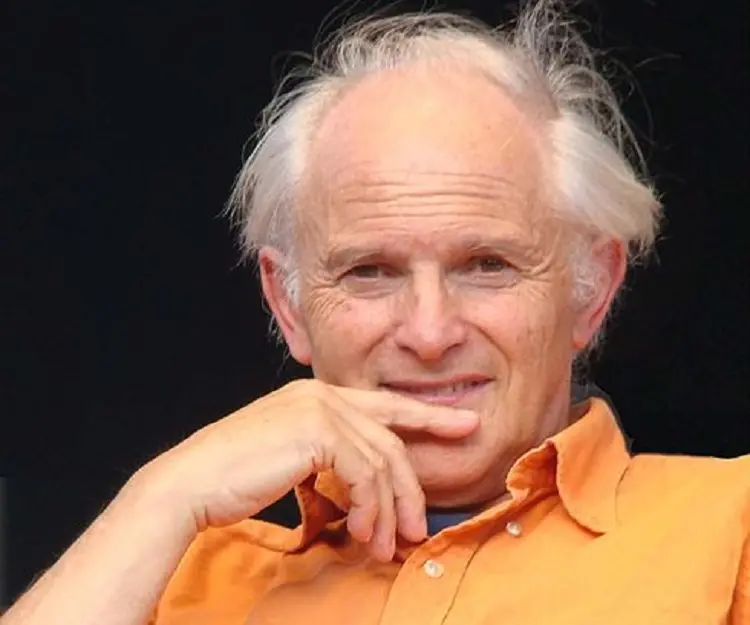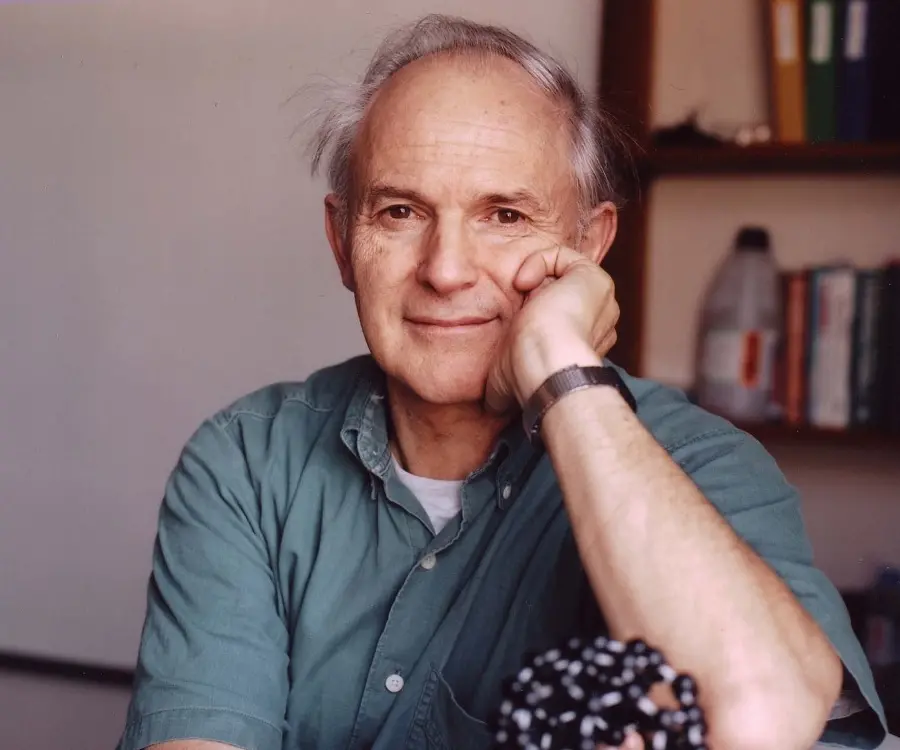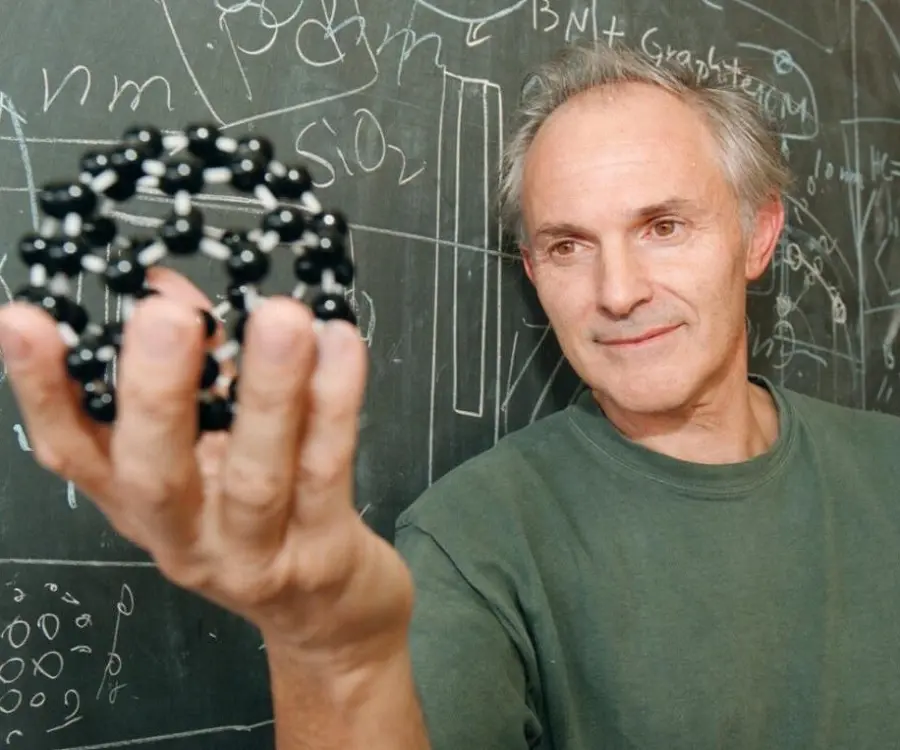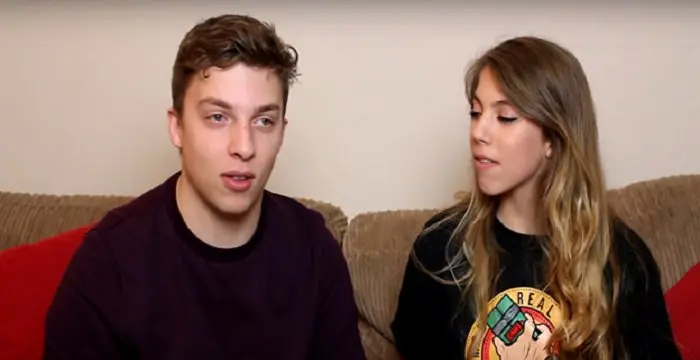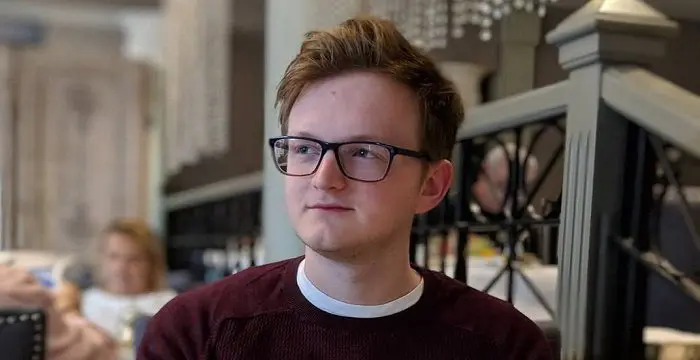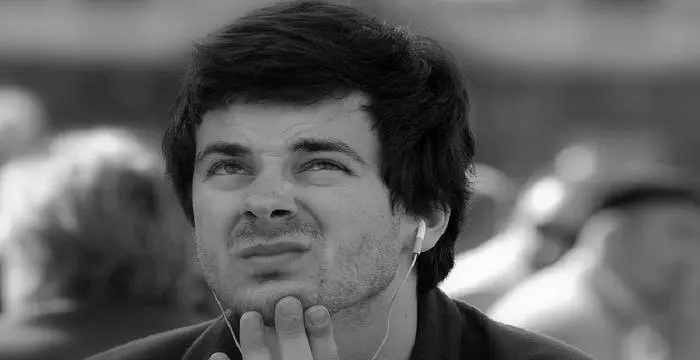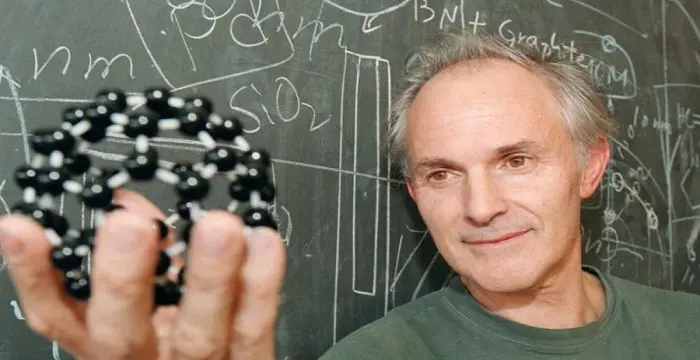
Sir Harold W. Kroto - Scientists, Family and Facts
Sir Harold W. Kroto's Personal Details
Sir Harold Walter Kroto was a Nobel Prize winning English chemist
| Information | Detail |
|---|---|
| Birthday | October 7, 1939 |
| Died on | April 30, 2016 |
| Nationality | British |
| Famous | Scientists, Chemists |
| Childrens | David and Stephen |
| Birth Place | Wisbech, United Kingdom |
| Gender | Male |
| Sun Sign | Libra |
| Born in | Wisbech, United Kingdom |
| Famous as | Chemist |
| Died at Age | 76 |
// Famous Chemists
Henry Cavendish
Henry Cavendish was a theoretical chemist and physicist, renowned for discovery of hydrogen and calculation of the mass of earth. To know more about his childhood, profile, timeline and career read on
Walter Kohn
Nobel Laureate Walter Kohn was an Austrian-born American theoretical chemist and physicist. Check out this biography to know about his childhood, life, achievements, works & timeline.
Jabir Ibn Hayyan
Jabir Ibn Hayyan was a medieval era polymath. Check out this biography to know about his life, works and achievements.
Sir Harold W. Kroto's photo
Who is Sir Harold W. Kroto?
Sir Harold Walter Kroto was a Nobel Prize winning English chemist, best known for the discovery of buckminsterfullerene. He was born in England as Harold Walter Krotoschiner about a month after the outbreak of the Second World War to a Jewish refugee from Berlin. Initially he had to work extra hard to assimilate with rest of the kids at school because of his surname. Later his father changed it to Kroto. At school, he was particularly fond of geography, art, woodwork and gymnastic. His interest began to gravitate towards chemistry, physics and mathematics when he reached A-level. Ultimately, he entered The University of Sheffield with chemistry and earned both is BSc and PhD from there. Subsequently, after a short stint of postdoctoral fellow in Canada and America, he joined the University of Sussex as a tutorial fellow, slowly working his way up to become a full professor. Concurrently, he worked on various topics. Creating the first molecules with carbon/phosphorus double bonds and the discovering the carbon chains in space are two of his most important works prior to his now famous work on buckminsterfullerene. He spent his later years, working relentlessly to bring science to everybody who cares for it.
// Famous Scientists
Juliane Koepcke
Juliane Koepcke is a German-Peruvian biologist, who was the lone survivor among the 92 passengers and crew of the ill-fated LANSA Flight 508 that crashed in the Peruvian rainforest on 24 December 1971. Know more about her life in this biography.
Henry Cavendish
Henry Cavendish was a theoretical chemist and physicist, renowned for discovery of hydrogen and calculation of the mass of earth. To know more about his childhood, profile, timeline and career read on
Konstantin Tsiolkovsky
Konstantin Tsiolkovsky was a Russian rocket scientist and a pioneer of astronautics. This biography provides detailed information about his childhood, family, personal life, career, achievements, etc.
Childhood & Early Life
Harold Walter Kroto was born as Harold Walter Krotoschiner on 7 October 1939 in Wisbech, Cambridgeshire, England. His father, Heinz Krotoschiner, was Jewish refugee from Berlin; but their family came from Krotoschin (now Krotoszyn) in Poland. The title Krotoschiner was derived from the town’s name.
Harold’s parents, Heinz and Edith Krotoschiner, ran a small business in Berlin. In 1937, with the rise of anti-Semitism in Germany, Heinz Krotoschiner escaped to England. Edith followed her husband.
Subsequently, they set up a small business in London. As the Second World War broke out, Heinz was interred on the Isle of Man as an enemy alien and Edith was evacuated to Wisbech, where Harold was born. In 1940, he and his mother were shifted to Bolton, Lancashire.
At the end of the war, the family settled down in Bolton. There they set up their home in the poor quarter of the town. Later, with the help of friends they opened a small balloon manufacturing factory.
In time, Harrold was enrolled at Bolton School, where his surname created a little problem and made him feel like an alien from another planet. It was a big relief when in 1955 his father changed their surname to Kroto.
Nonetheless, he enjoyed his school life like any other kids. However unlike others, he spent the holidays working at his father’s factory doing all kind of jobs; from replacing workers in the production line to taking bi-yearly stocks.
Over the time, chemistry became his most favorite subject and after graduating from school in 1958, he entered the University of Sheffield with chemistry.
Initially, he was interested in organic chemistry. But later it shifted to quantum chemistry and spectroscopy. At the same time, he played tennis, took part in university athletics and learned to play the guitar well. He also acted as the art editor of the students’ magazine, designing the magazine’s cover, advertising posters etc.
In 1961, Kroto earned his Bachelor of Science degree with a first class honors in chemistry. Remaining at the same university, he next began working for his PhD with Richard Dixon on spectroscopy of free radicals produced by flash photolysis, earning his doctoral degree in 1964. His dissertation was titled ‘The spectra of unstable molecules under high resolution’.
Career
In 1964, Harold Kroto began his career as a postdoctoral fellow at the National Research Council in Ottawa, Canada. Here he worked with Don Ramsay on flash photolysis/spectroscopy and discovered a singlet-singlet electronic transition of the NCN radical. Later in 1965, he worked on the rotational spectrum of NCN3 with Cec Costain.
In 1966, he received another postdoctoral position at the Bell Laboratory in New York, U.S.A. Here he worked with Yoh Han Pao on liquid phase interactions by laser Raman spectroscopy.
In 1967, he returned to England and joined the faculty of School of Chemistry & Molecular Sciences (MOLS) at University of Sussex as a tutorial fellow. Fortunately, he was made a permanent lecturer within a short time.
By 1970, Kroto completed his work in the electronic spectroscopy of gas phase free radicals and rotational microwave spectroscopy. He also built He-Ne and argon ion lasers to study intermolecular interactions in liquids and with it he carried out theoretical calculations.
In 1974, after a lot of haggling, Kroto finally got his own spectrometer. Previously, the team had to make monthly visit to Reading for that. Now with their own spectrometer in Sussex they started studying carbon chain species HC5N. The work was the starting point of his discovery of C60 more than ten years later.
In 1975, Kroto began to work with David Walton, also of the University of Sussex, on long linear carbon chain molecules. By now, it was revealed by Canadian astronomers that some strange carbonaceous species can be found in large abundance in interstellar space as well as in the carbon-rich red giant stars.
Wishing to study how these chains are formed, he started looking for a laser vaporizing apparatus. Subsequently, he contacted Professor Robert F. Curl of Rice University, who told him that his colleague Richard E. Smalley had one.
Therefore in 1985, Kroto joined them at Rice and apart from finding long chain carbon, they found a carbon molecule with 60 atoms; they named it buckminsterfullerene. The work led to the discovery of a new allotrope of carbon known as a fullerene.
Returning to Sussex he began working on the implication of his discovery. At the same time, he started working on educating general public on discoveries of science and in 1995, established Vega Science Trust, a non-profit organization, for that purpose.
In 2004, he left the University of Sussex and became Francis Eppes Professor of Chemistry at Florida State University. Here he continued his work on the astrochemistry of fullerenes in stellar space.
Later he collaborated with Allan Marshal to work on carbon vapor and with Naresh Dalal of FSU and Tony Cheetham of Cambridge to work on open framework condensed phase systems and nano-structured systems. At the same time, he kept on working on various projects with the aim of educating the masses.
In 2006, Kroto founded Global Educational Outreach for Science Engineering and Technology (GEOSET). Its main website consists of an ever-growing collection of recorded teaching module that can be freely downloaded both by educators and public.
Major Works
Kroto is best remembered for his discovery of buckminsterfullerene, a work he undertook with Robert Curl and Richard Smalley. They vaporized graphite in an atmosphere of helium. This generated cluster of carbon molecules, most of which contained 60 atoms. They next began to study these C60 molecules. Finally, they found that the atoms are bonded together in a symmetrical hollow structure, resembling a sphere. Kroto, who had been interested in graphic art, named it buckminsterfullerene after American architect R. Buckminster Fuller, because the molecules reminded him of the geodesic dome designed by Fuller.
Awards & Achievements
In 1996, Kroto received the Nobel Prize in Chemistry jointly with Robert F. Curl Junior and Richard E. Smalley "for their discovery of fullerenes".
International Prize for New Materials American Physical Society (1992), Italgas Prize for Innovation in Chemistry (1992), Carbon Medal (1997), Faraday Award (2001) and Copley Medal (2002) are some other significant awards received by him.
In 1990, Kroto was elected a Fellow of Royal Society.
In the 1996 New Year Honor List, he was made a Knight Bachelor.
Personal Life & Legacy
In 1963, while working for his PhD at the University of Sheffield, Harold Kroto married Margaret Henrietta Hunter, also a student of the same university. The couple had two sons; Stephen and David.
He was also a lover of film, theatre, music and art. He had produced and published many art work and graphic designs, for which he had also earned many prizes and awards.
He was an atheist and a patron of British Humanist Association, a charitable organization that represents "people who seek to live good lives without religious or superstitious beliefs".
Towards the end of his life, Kroto developed amyotrophic lateral sclerosis. On 30 April 2016, he died in Lewes, East Sussex, England from complications arising out of the disease.
Trivia
Kroto believed that, if he had the right guidance, he would have certainly studied something like architecture because it would have combined his interest in art and science. Unfortunately, during his time general career advice was not available.
// Famous Libra Celebrities peoples
Melissa Brim
Melissa Brim is the ex-girlfriend of former professional boxer Floyd Mayweather Jr. Check out this biography to know about her birthday, childhood, family life, achievements and fun facts about her.
Jacob Tremblay
Jacob Tremblay is a Canadian child actor. Let’s have a look at his family & personal life including age, birthday, relationships, net worth and fun facts.
Sierra Furtado
Check out all that you wanted to know about Sierra Furtado, the famous YouTube Personality; her birthday, her family and personal life, her boyfriend, fun trivia facts and more.
Sir Harold W. Kroto's awards
| Year | Name | Award |
|---|---|---|
Other | ||
| 1994 | EPS Europhysics Prize | |
| 1992 | James C. McGroddy Prize for New Materials | |
| 0 | 1996 - Nobel Prize in Chemistry | |
| 0 | 2004 - Copley Medal | |
| 0 | 2001 - Michael Faraday Prize | |
Sir Harold W. Kroto biography timelines
- // 1937Harold’s parents, Heinz and Edith Krotoschiner, ran a small business in Berlin. In 1937, with the rise of anti-Semitism in Germany, Heinz Krotoschiner escaped to England. Edith followed her husband.
- // 7th Oct 1939Harold Walter Kroto was born as Harold Walter Krotoschiner on 7 October 1939 in Wisbech, Cambridgeshire, England. His father, Heinz Krotoschiner, was Jewish refugee from Berlin; but their family came from Krotoschin (now Krotoszyn) in Poland. The title Krotoschiner was derived from the town’s name.
- // 1940Subsequently, they set up a small business in London. As the Second World War broke out, Heinz was interred on the Isle of Man as an enemy alien and Edith was evacuated to Wisbech, where Harold was born. In 1940, he and his mother were shifted to Bolton, Lancashire.
- // 1955In time, Harrold was enrolled at Bolton School, where his surname created a little problem and made him feel like an alien from another planet. It was a big relief when in 1955 his father changed their surname to Kroto.
- // 1958Over the time, chemistry became his most favorite subject and after graduating from school in 1958, he entered the University of Sheffield with chemistry.
- // 1961 To 1964In 1961, Kroto earned his Bachelor of Science degree with a first class honors in chemistry. Remaining at the same university, he next began working for his PhD with Richard Dixon on spectroscopy of free radicals produced by flash photolysis, earning his doctoral degree in 1964. His dissertation was titled ‘The spectra of unstable molecules under high resolution’.
- // 1963In 1963, while working for his PhD at the University of Sheffield, Harold Kroto married Margaret Henrietta Hunter, also a student of the same university. The couple had two sons; Stephen and David.
- // 1964 To 1965In 1964, Harold Kroto began his career as a postdoctoral fellow at the National Research Council in Ottawa, Canada. Here he worked with Don Ramsay on flash photolysis/spectroscopy and discovered a singlet-singlet electronic transition of the NCN radical. Later in 1965, he worked on the rotational spectrum of NCN3 with Cec Costain.
- // 1966In 1966, he received another postdoctoral position at the Bell Laboratory in New York, U.S.A. Here he worked with Yoh Han Pao on liquid phase interactions by laser Raman spectroscopy.
- // 1967In 1967, he returned to England and joined the faculty of School of Chemistry & Molecular Sciences (MOLS) at University of Sussex as a tutorial fellow. Fortunately, he was made a permanent lecturer within a short time.
- // 1970By 1970, Kroto completed his work in the electronic spectroscopy of gas phase free radicals and rotational microwave spectroscopy. He also built He-Ne and argon ion lasers to study intermolecular interactions in liquids and with it he carried out theoretical calculations.
- // 1974In 1974, after a lot of haggling, Kroto finally got his own spectrometer. Previously, the team had to make monthly visit to Reading for that. Now with their own spectrometer in Sussex they started studying carbon chain species HC5N. The work was the starting point of his discovery of C60 more than ten years later.
- // 1975In 1975, Kroto began to work with David Walton, also of the University of Sussex, on long linear carbon chain molecules. By now, it was revealed by Canadian astronomers that some strange carbonaceous species can be found in large abundance in interstellar space as well as in the carbon-rich red giant stars.
- // 1985Therefore in 1985, Kroto joined them at Rice and apart from finding long chain carbon, they found a carbon molecule with 60 atoms; they named it buckminsterfullerene. The work led to the discovery of a new allotrope of carbon known as a fullerene.
- // 1990In 1990, Kroto was elected a Fellow of Royal Society.
- // 1995Returning to Sussex he began working on the implication of his discovery. At the same time, he started working on educating general public on discoveries of science and in 1995, established Vega Science Trust, a non-profit organization, for that purpose.
- // 1996In 1996, Kroto received the Nobel Prize in Chemistry jointly with Robert F. Curl Junior and Richard E. Smalley "for their discovery of fullerenes".
- // 1996In the 1996 New Year Honor List, he was made a Knight Bachelor.
- // 2004In 2004, he left the University of Sussex and became Francis Eppes Professor of Chemistry at Florida State University. Here he continued his work on the astrochemistry of fullerenes in stellar space.
- // 2006In 2006, Kroto founded Global Educational Outreach for Science Engineering and Technology (GEOSET). Its main website consists of an ever-growing collection of recorded teaching module that can be freely downloaded both by educators and public.
- // 30th Apr 2016Towards the end of his life, Kroto developed amyotrophic lateral sclerosis. On 30 April 2016, he died in Lewes, East Sussex, England from complications arising out of the disease.
// Famous British peoples
Wentworth Miller
Wentworth Miller is an American actor and screenwriter who achieved recognition for his role in the TV series ‘Prison Break’.
Sophie Reade
Sophie Victoria Reade is a British model and reality show star. Let’s take a look at her family and personal life, including her age, birthday, boyfriends, and some interesting facts.
Josh Temple
Check out all that you wanted to know about Josh Temple (Slogoman), the famous British YouTube Personality; his birthday, his family and personal life, his girlfriends, fun trivia facts and more.
Yammy Xox
Check out all that you wanted to know about Yammy Xox, the famous British YouTube Personality; her birthday, her family and personal life, her boyfriends, fun trivia facts and more.
Grian
Grian is an English YouTube gamer and social media influencer. Check out this biography to know about his birthday, childhood, family life, achievements and fun facts about him.
Benjamin Atkinson
Benjamin Atkinson is the son of the world-renowned British actor and comedian, Rowan Atkinson. Check out this biography to know about his childhood, family, personal life, including his age, birthday, etc.
Sir Harold W. Kroto's FAQ
What is Sir Harold W. Kroto birthday?
Sir Harold W. Kroto was born at 1939-10-07
When was Sir Harold W. Kroto died?
Sir Harold W. Kroto was died at 2016-04-30
Which age was Sir Harold W. Kroto died?
Sir Harold W. Kroto was died at age 76
Where is Sir Harold W. Kroto's birth place?
Sir Harold W. Kroto was born in Wisbech, United Kingdom
What is Sir Harold W. Kroto nationalities?
Sir Harold W. Kroto's nationalities is British
Who is Sir Harold W. Kroto childrens?
Sir Harold W. Kroto's childrens is David and Stephen
What is Sir Harold W. Kroto's sun sign?
Sir Harold W. Kroto is Libra
How famous is Sir Harold W. Kroto?
Sir Harold W. Kroto is famouse as Chemist



